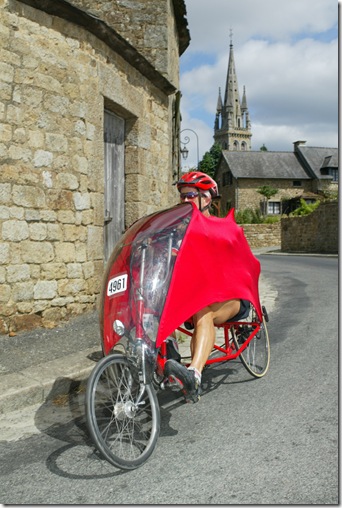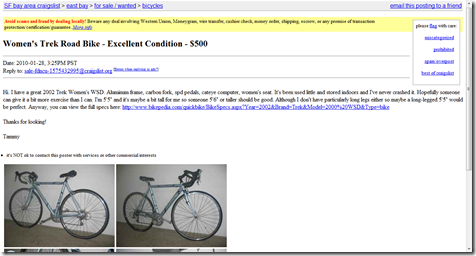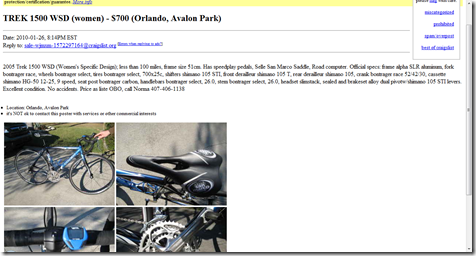This post includes two sections – one section by my Dad on how to buy a new bike, and one section by me on how to buy a used bike. My dad and I have been bike riding together since I was a little kid!
![[CIMG7110[3].jpg]](http://lh3.ggpht.com/_DOQrQIzggu8/Slyr01BzclI/AAAAAAAALsA/TLNvXCyY6mU/s1600/CIMG7110%5B3%5D.jpg)
This post discusses how to buy a road bike (for racing, club rides, or triathlons), but a lot of the principles can be applied to a hybrid or mountain bike.
You can learn more about my Dad’s cycling background (which is extensive and awesome!) on this post.
How to Buy a New Bike by HTP Dad
Caitlin mentioned that her readers have asked about what kind of bike to buy, or how much you should spend, or why so many people in bike stores are not so friendly to newbies in the sport. I’ve done a lot of cycling, so here’s my take on it.

A lot of people ask Caitlin and I which brand of bike they should buy. There are many good brands, like Specialized, Trek, Giant, Fuji, etc. The bike business is SO competitive, whatever brand they sell you will probably be fine. A good vibe from the store and after service sales is probably more important than the actual bike brand you purchase.
Read this article on Bike Fit to brush up on your basic knowledge about getting sized for a bicycle. Make sure you know the proper frame size, and push them to help get you in the ball park for fit. Since you know a little bit about bike fit – even knowing just to ask for it – it’ll probably go well.
Now – how much do you REALLY need to spend on a bike?
I’ll use Trek for an example, because they are huge in the bike market.
The Road 1.1 WSD (woman specific design) has a list price of $659, and if you are a fitness rider, and your big annual event might be a metric century (62 miles) you’ll be fine with this. If you plan on riding a lot (30-50 miles a week) a little more money will buy a lot more reliability.

The Road 1.5 WSD brings you up to the previous generation of technology for $1059. The big difference? 9 gears instead of 8 in the rear, and some minor upgrades in other components. If you’re going to be ride even more, one more step up would be worthwhile – but by that point, you’re a serious cyclist.

The Road 2.1 WSD at $1369 gets you into high quality, current generation parts. Honestly, at this point, you’ll be riding a bike better than pro’s rode fifteen years ago.

From this point up – and up can be way up – you will get the reliability to ride thousands of miles annually, in any kind of weather conditions, with low maintenance.
There are two ways to spend lot’s more money: get crazy about low weight and what is known as "bike jewelry" – top of the line components that, really are beautiful in their boxes when you buy them. Low weight – unless you really are a very serious, competitive cyclist – is not that big a deal. Two water bottles weigh almost 5 pounds – and I had very few seasons where I couldn’t have lost 8 or ten pounds myself.
A secret? If you want a sportier feel, buy a set of high performance, light weight wheels and pop them on a more affordable bicycle.
Yes, a more expensive bike will feel more responsive, and ultimately be faster – just like a Ferrari is more fun to drive than a Ford truck – but the engine (YOU!) is the important part. Start riding!
How to Buy a Used Bike by HTP Caitlin
When I first started riding, I had no idea if I would stick with it or not. Plus, I was only 1 year into my first full-time job and was planning a wedding. I didn’t want to drop $700 – $1400 on a bike. So… I found a used one! My Giant bike was originally $1400 and I snagged it for $350.
![[DSCN9983[3].jpg]](http://lh3.ggpht.com/_DOQrQIzggu8/SiLFrtJ20II/AAAAAAAAKGg/wI3OpD04G_8/s1600/DSCN9983%5B3%5D.jpg)
When buying a used bike, my first piece of advice is to read up on Bike Fit and then go to a bike shop to look at new bikes. Get on a few bikes and find out what size you want to look for. While you’re at the shop, buy some bike shorts or a water bottle – you’ll need it anyway!
Your best resources for a used bike are Ebay.com and Craiglist.com. I prefer Craigslist because you can actually see the bike in person.
The most important thing is that the frame has not been damaged or cracked, which is the sign of a serious crash. Rusty chains and other minor defects can be easily fixed at the shop, but a bad frame is a big deal. So inspect the bike carefully for any cracks.
If you plan on racing, you definitely want drop handle bars (like my pink ones, above) NOT a straight bar.
Lastly, make sure you HAGGLE. I think both of the bikes above are overpriced and would convince the seller to drop at least $100 to $150 off. Google the current price of that bike (especially if it’s a newer bike “only ridden once†– everyone says that and odds are that it’s NOT true). Point out old tires, rusty chains, peeling paint jobs – whatever. Remember that everyone overprices things so they can negotiate them down later! Don’t be afraid to ask. Worse case scenario, they say no and you keep looking.
Buying a used bike can be time-consuming (it took me weeks!), but the payoff is worthwhile.
Happy Biking! If you have any questions for my dad or I, feel free to ask in the comments section.
Do you have a bike? Is it new or used? What advice can you give to other bike shoppers?



My dad and I have biked our entire lives together, too! He races, but I have yet to race. I have new Trek – not new since I’ve had it for years, but I bought it new. I am not a seasoned biked and really just bike for fun, so I don’t have a ton of advice. I just know about 150 milers my dad get’s really sick of bananas. 🙂